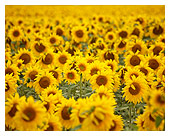Sunflower Farming
You might have passed by them while driving in a car, or riding a train - sunflower farms. The sunflower is a marketable crop product, and of all crops harvested for seed, the sunflower is the only one that was domesticated in North America. This widely adapted crop is now grown in every temperate region of the world, including many parts of the U.S and Canada. Although the sunflowers themselves are generally not exported, the products derived from them are. Sunflower farms play an important role in the world economy and the oncoming oil crisis may determine a further importance of sunflower farms if petroleum product alternatives are more fully researched and required. Read on to learn more about sunflower farms!
Sunflowers - Growing as a Crop
 The sunflower can produce vast quantities of oil per acre sown, since oilseed sunflower varieties are approximately 40 - 50% oil by weight. Sunflower seed yields can exceed 3000 pounds per acre, but more commonly, crops tend to average between 1200 - 2000 pounds per acre. Sunflower seed yields are less determined by dry spells than by pest pressures and the initial seed selction. As with most crops, if you choose to grow sunflowers at a commercial level, you need to find a market to sell to. If you want to produce sunflower oil, is there a local pressing plant that can extract the oil? Or a seed milling operation if you are looking to sell birdseed for market? After consideration of these questions, a small acreage should be planted to help determine potential yields and see what local pests or soil diseases threaten your crop.
The sunflower can produce vast quantities of oil per acre sown, since oilseed sunflower varieties are approximately 40 - 50% oil by weight. Sunflower seed yields can exceed 3000 pounds per acre, but more commonly, crops tend to average between 1200 - 2000 pounds per acre. Sunflower seed yields are less determined by dry spells than by pest pressures and the initial seed selction. As with most crops, if you choose to grow sunflowers at a commercial level, you need to find a market to sell to. If you want to produce sunflower oil, is there a local pressing plant that can extract the oil? Or a seed milling operation if you are looking to sell birdseed for market? After consideration of these questions, a small acreage should be planted to help determine potential yields and see what local pests or soil diseases threaten your crop.
Sunflowers - Choosing a Variety
Sunflower varieties grown as crops have steadily improved with time. There are many varieties and hybrids available, including dwarf sunflowers with large seed heads and sunflowers that produce oil with unique saleable properties (such as a high percentage of oleic acid). Some varieties are chosen for how big the seeds are, especially when growing to cater to the snack food or birdseed market. It is very common for hybrid sunflowers to be grown for cropping since they are most common and typically have higher yields. And many of these hybrid sunflowers do not need insects to pollinate them, a bonus for large plantings.
Sunflower Farms – Size
Because sunflowers grow quite tall and large, and do not benefit from growing too close together, sunflower farms can be quite enormous. A lot of space on a sunflower farm is required to in order to yield the desirable amount of sunflowers. Sunflower farm fields could stretch from the side of a country road out to the horizon, and all you will be able to see will be sunflowers. While growing, it is not uncommon that regular folks that do not know anything about growing crops will mistake sunflower farms for corn farms - they are not visually unlike each other, at least not until the sunflower blooms!
Sunflower Farms – Harvesting
A sunflower is ready to harvest when the back portion of the head turns brown. The seeds mature earlier than this, typically when the back of the sunflower head is yellow and the petals have fallen off, but the head will be too wet for harvest by machines until the brown color appears. Timely harvest is important to minimize seed loss due to birds or late season diseases. Birds are a great enemy of sunflower farms since they love sunflower seeds as much as humans do! To harvest the seeds safely and effectively, and to ensure the seed heads are protected from being shattered, you need a modified grain head on a combine. These can be purchased (or a regular combine can be modified manually) but this is best discussed with a knowledgeable farm supply shop.
Sunflower Farms – Location
Due to the massive amount of space needed to grow sunflowers many sunflower farms are located in Russia, although there are a good percentage of farms in the mid-west states in the U.S. cropping sunflowers. In Russia there is a lot of good land suitable for growing large sunflower crops, plus Russia benefits from the fact that there are less native pests and soil diseases to threaten the yield. Although Russia produces a great deal of seed, Argentina comes in a close second, followed by China, India, Turkey and South Africa. Although there is a lot of great land for growing sunflowers the U.S. is not nearly close when it comes to number of sunflower farms and amount of sunflowers produced. This is probably because a lot of this land is taken up by corn fields, something seldom found in Russia, but quite regularly found in Argentina where sunflower farms and corn farms tend to grow their crops right next to each other, in harmony.